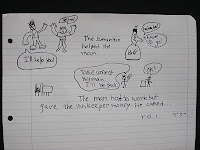


The Parable of the Good Samaritan is precipitated by and in answer to a question posed to Jesus by a lawyer,
"Teacher, what shall I do to inherit eternal life?" (Luke 10:25).
In this case the lawyer would have been an expert in the Mosaic Law and not a court lawyer of today.
This question provided Jesus with an opportunity to define what His disciples' relationship should be to people in distress. Jesus focuses on relationships and what it means to be someone's neighbour.
The text says that the scribe (lawyer) had put the question to Jesus as a test. The scribe was making the assumption that man must do something to obtain eternal life. Jesus will answer the question using what is called the Socratic method; i.e. answering a question with a question, “He said to him, "What is written in the law? What is your reading of it?" (Luke 10:26). By referring to the Law, Jesus is directing the man to an authority they both would accept as truth, the Old Testament. The scribe answers Jesus’ question by quoting Deuteronomy 6:5 and Leviticus 19:18.
Here are some simple illustrations by students.
No comments:
Post a Comment